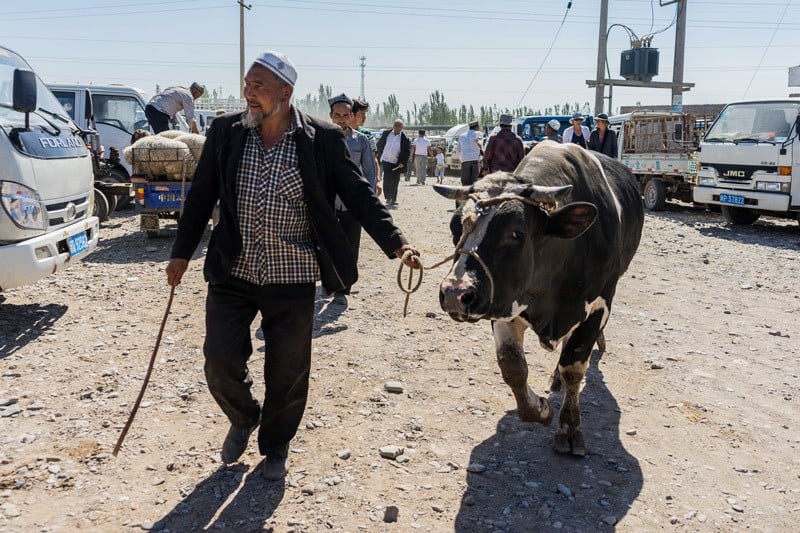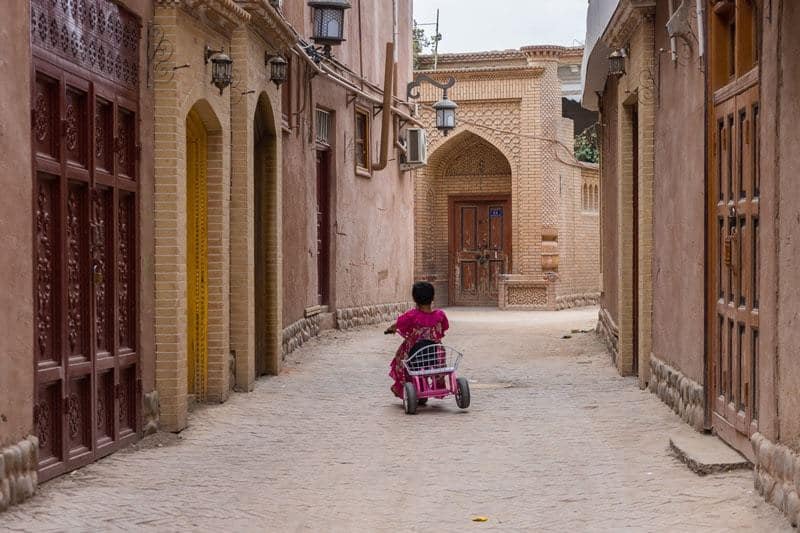Chanting from the Id Kah Mosque echoes over the city while the smell of sizzling shish kebabs on every street corner drifts through the air.
Vehicles veer around elderly men riding donkeys as they herd their fat-tailed sheep on the wide streets.
Arabic script adorns every street sign and shop window. The women wear hijabs and the men sport Takiyah caps.

Geographically closer to Damascus than to Beijing, the Uyghur city of Kashgar in China’s Xinjiang province is another world away from the rest of the country in every possible way.
Kashgar is an eclectic mix of culture, religion and culinary delights. From the moment we stepped off the train from the provincial capital Urumqi we felt like we had crossed an imaginary border and entered Central Asia.
Our main purpose for arriving in the far south of the province was to trek along the Karakoram Highway towards the border of Pakistan, but we knew instantly that this city deserved some exploration.
Feeling the excitement that came with being in this new foreign city, we chose to make the Seman Hotel our base while in Kashgar, which in itself already brought a taste of history and intrigue to our visit.
Housed in the old Russian Consulate, the Seman Hotel is a curiously-designed establishment with colourful Uyghur décor.
It may be more than a little run-down, but at least it boasts character. It is also where Old Road Tours has set up their headquarters, and we had already organised a city tour of Kashgar with them.

Our Kashgar City Tour
On a gorgeous Sunday morning we met our English-speaking guide Pati and driver Abdul Letip, and didn’t waste any time hitting the road to explore the city’s best sights.
The first destination on our Kashgar city tour was the tomb of Afak Khoja, about 8km from the city centre.
Afak Khoja had the mausoleum built in 1640 after his father Muhammad Yūsuf passed away.
When Apak Hoja also died he was placed inside next to his father. Today 72 members of his family are housed inside the mausoleum, including the legendary Fragrant Concubine – the wife of the Qianlong Emperor who was taken from Xinjiang to Beijing in the 18th century to be an imperial consort.
The Afak Khoja Mazar is the finest example of Islamic architecture in Xinjiang, and its ancient tiles still glisten brightly against the sun’s rays.
Pati showed us all around the property and explained the history of the tomb.
We wandered through the prayer halls and studied the intricate carvings on the supporting pillars.
This was our first taste of true Islamic style since Xi’an, and we were in absolute awe.

Leaving the tomb Abdul Letip took us straight to Kashgar’s most famous attraction, the livestock bazaar.
We had managed to time our arrival to be on the weekend, which would allow us to visit the famous Sunday market.
Here thousands of locals gather to buy, sell and trade a whole range of livestock.
If you are looking to purchase a camel, cow, horse, donkey, yak, goat or fat-tailed sheep, then you have come to the right place!
We weren’t exactly in the market for a donkey or a camel (although I thought long and hard about putting a bid down, much to Lesh’s aghast disagreement), but the livestock bazaar was a fascinating place nonetheless.
Pati gave us a detailed explanation of how the system works, the average price for each particular breed (30’000RMB for a high-quality camel, anyone?) and what to expect as we walked through the bazaar.
He then set us off to our own devices, and we immediately found ourselves in the middle of a frantic and chaotic cow negotiation.
Determined Uyghur men inspected every inch and crevice of the bewildered beast while a middle-man talked prices with the owner.
The group didn’t mind us observing, and many of the men smiled and nodded towards us.
The sale went down and we continued on our way, navigating through the pandemonium.
The bazaar is broken up into different sections. Cows and yaks in one area, goats and fat-tailed sheep in another.
At the far end of the market horses are test-ridden at full gallop through the crowds and donkeys stand around making asses of themselves.
Cries of “Bosh bosh” are called out every few moments as herders bring their livestock charging through the crowds.
Any lapse in concentration could end with being trampled by a cow, so our eyes were constantly darting in every direction trying to avoid untimely death.
Clouds of thick dust billowed eerily. The noise shook us to our bones. It was true mayhem, and it was thoroughly enjoyable.



After two hours we had managed to escape unscathed (and sadly without a donkey) and we headed back to town to visit the ‘normal’ Sunday market.
This one is a much more relaxed affair, and far more colourful. Almost anything you could ever need is for sale inside this enormous bazaar.
Need a new scarf or bolt of silk? You’ve come to the right place. Kitchen utensils? They’ve got you covered. Want to buy a yurt? Well, step right this way good sir.
We wandered around for a while soaking up the bustling atmosphere. Since we didn’t have a donkey to carry a new yurt, Lesh settled for a couple of new scarves and we rejoined Pati in a carpet shop to drink some tea.
Our shopping fix was over and we strolled over to the Kashgar Old Town.
There are actually two parts of the Old Town – the freshly renovated yet still beautiful Areya Street and the dilapidated mud-brick shacks by Donghui Park.
Even though tourists are not officially allowed to visit the original Old Town, no authorities are there to patrol it, so Pati gave us a magnificent tour through its labyrinth-like alleyways.
Many of the homes are collapsing, and the government are forcing the local inhabitants out of their beloved neighbourhood and into new controlled housing.
But for the meantime children dart in and out of shadowed doorways playing games and the seniors relish in the final remains of their historic dwellings.


Areya Street at first seemed to us to be like the Disneyland-esque streets of Lijiang, but it quickly became apparent that despite the modern refurbishments it still retained its authentic charm.
Skilled furniture makers still practice their ageing craft by hand. Blacksmiths hammer away at pieces of iron in darkened rooms on the edge of the clean streets.
Fruit sellers hustle and instrument makers bustle. It is one of the most happening places in the entire city, surrounded by soaring Uyghur design and emotion.
Our final stop for the day was the Id Kah Mosque, the largest mosque in China.
Originally built in 1442 but restored many times over the years, the Id Kah Mosque draws thousands of worshippers every week.
During the most important Islamic celebrations such as Ramadan and the Kurban Festival up to 20’000 people can pack the outside square.
During prayer times the mosque is closed to non-Muslims, however the rest of day it is open to visitors for a small fee.
Out of respect, it is asked that women wear a scarf over their head, and luckily Lesh had just stocked up at the market.
Pati gave another superb explanation of the history of the mosque, and a thorough run-down on Islam for us.
The inside of the mosque was strictly practical but the grounds were peaceful to walk around.
The centrepiece inside the prayer hall is an enormous and highly-valued Persian carpet that was gifted to the people of Kashgar from Iran.
After 30 minutes of wandering the holy place we started to make our way back to our accommodation. But not before we gorged ourselves on a few shish kebabs and home-made ice cream.

Our city tour of Kashgar was incredibly interesting and it helped cement the Uyghur town as one of our favourite places in China.
Pati had been an impeccable guide and taught us more about his city and religion than any guide book ever could.
We now looked at Kashgar and its people in an entirely different light. And even though I never got to buy a donkey, it was still a sensational day.
Where to Stay in Kashgar
The accommodation in Kashgar can range from basic dorm beds in a hostel to lovely double rooms in a boutique hotel.
Some of the hostels have great common rooms to chat with other travellers and separate female dorms for your comfort. There are some located in the old town which is a great location for all the best attractions in Kashgar.
If you want to be a little more comfortable for a reasonable price there are nice hotels to choose from. But if you want to splash out and live it up, you can find hotel chains, such as the Radisson there also.
For great deals on accommodation in Kashgar, check out Agoda.com and Booking.com
Update – Visiting Kashgar Today
In recent years the Chinese government has come under scrutiny for their oppression of the Uyghur people, the abhorrent use of concentration camps and removal of religious elements.
For the local population, these threats are real and dangerous. There is no question that these are some of the most horrible violations of human rights happening in the 21st century.
For a general traveller visiting Kashgar or other parts of the Xinjiang province, these atrocities will not be obviously apparent.
Travellers will notice heightened security in Xinjiang, and the Uyghur population may be hesitant to discuss the current political situation with foreigners.
For your own safety when travelling around Kashgar and Xinjiang, we recommend refraining from speaking publicly about the government while you are in the country.



2 thoughts on “A Day in Kashgar – China’s Eclectic Uyghur City”
I’m in Kashgar September 13. Reading your blog gave me goose bumps, so excited.
Hope you had a great trip. 🙂